Spatial and Data-Driven Approaches for Mitigating Urban Heat in Coastal Cities
Abstract
1. Introduction
2. Study Area and Data
2.1. Study Area
2.2. Data Sources and Processing
3. Methodology
3.1. Overview
3.2. Machine Learning-Based LCZ Classification Method
3.3. LST and UHII Calculation
3.4. XGBoost–SHAP Machine Learning Model
3.5. Causal Inference
3.5.1. Causal Variable Selection and DAG Construction
3.5.2. Confounder Identification and Validation
3.5.3. Causal Effect Estimation
3.5.4. Robustness Tests and Sensitivity Analysis
4. Results
4.1. Block-LCZ Classification Results
4.2. Spatial Distribution of UHIs and Thermal Characteristics of Various LCZ Types
4.3. Impact of Multidimensional Urban Influencing Factors on UHII in Coastal Cities
4.3.1. Model Performance Evaluation and Validation
4.3.2. Factor Importance and SHAP Value Analysis
4.3.3. Marginal Effects Analysis
4.4. Causal Inference of Key Influencing Factors on UHII in Coastal Cities
5. Discussion
5.1. Spatial Differentiation Characteristics and Mechanism Analysis of Urban Heat Islands in Coastal Cities
5.2. Regional Differences in Multidimensional Influencing Factor Mechanisms
5.3. UHI Mitigation Strategies Based on Causal Inference
5.4. Limitations
6. Conclusions
- (1)
- Significant spatial differentiation of UHII exists among coastal cities, with Hong Kong exhibiting the highest average UHII (2.63 °C) and northern coastal cities generally showing higher values than southern cities. At the LCZ scale, compact building blocks (LCZ 1–3) consistently demonstrate stronger heat island effects than open building blocks (LCZ 4–6), with LCZ 2 showing the most intense heat island effect, while LCZ G and LCZ A blocks provide stable cooling effects across all cities.
- (2)
- Machine learning models identify distinct nonlinear response patterns of urban factors to UHII. NTL and DS emerge as universally important factors across all cities, while NDVI consistently shows strong negative impacts with optimal cooling effects in the 0.2–0.4 interval. However, factor importance varies significantly between cities—PD ranks in the top two factors in Haikou and Shanghai but shows weak influence in Dalian, while SVF demonstrates high contribution in Hong Kong but limited roles elsewhere.
- (3)
- Causal inference quantifies city-specific causal relationships between key factors and UHII, enabling differentiated mitigation strategies. Cities with high NDVI elasticity coefficients (Quanzhou and Xiamen) should prioritize vegetation optimization, while Dalian requires focus on building layout optimization given the strong causal effects of building density. The DS causal effects show regional differentiation—negative effects in Qingdao, Xiamen, Hong Kong, Haikou, and Quanzhou suggest potential for enhancing ocean cooling through controlled coastal development, while positive effects in Shanghai and Qinhuangdao indicate the need to protect sea–land ventilation corridors.
Author Contributions
Funding
Data Availability Statement
Conflicts of Interest
Abbreviations
| AI | Aggregation Index |
| ALB | Albedo |
| ATE | Average Treatment Effect |
| BD | Building Density |
| BH | Building Height |
| COH | Patch Cohesion Index |
| DS | Distance from Sea |
| GEE | Google Earth Engine |
| LCZ | Local Climate Zone |
| LSI | Landscape Shape Index |
| LST | Land Surface Temperature |
| LSWI | Land Surface Water Index |
| MNDWI | Modified Normalized Difference Water Index |
| NDBI | Normalized Difference Built-up Index |
| NDSVI | Normalized Difference Soil Vegetation Index |
| NDVI | Normalized Difference Vegetation Index |
| NTL | Nighttime Light |
| PD | Population Density |
| SHAP | Shapley Additive Explanations |
| SHDI | Shannon’s Diversity Index |
| SPL | Split Index |
| SVF | Sky View Factor |
Appendix A
| City | Treatment | Outcome | ATE | Elasticity | Relative Importance | Placebo | Random Cause | Subsample |
|---|---|---|---|---|---|---|---|---|
| Dalian | BD | UHII | 8.07051 | 0.60186 | 0.14291 | −0.01030 | 8.07009 | 8.12895 |
| NDVI | UHII | −4.28838 | −0.46126 | 0.04015 | −0.01191 | −4.28818 | −4.28994 | |
| NTL | UHII | 0.07106 | 0.60780 | 0.12581 | −0.00008 | 0.07106 | 0.07123 | |
| Qinhuangdao | DS | UHII | 0.00002 | 0.15649 | 0.07192 | 0.00000 | 0.00002 | 0.00002 |
| SHDI | UHII | −2.91147 | −0.97548 | 0.27502 | −0.02546 | −2.91131 | −2.91735 | |
| NTL | UHII | 0.06446 | 0.35938 | 0.11970 | −0.00103 | 0.06445 | 0.06478 | |
| Qingdao | DS | UHII | −0.00007 | −0.26386 | 0.08618 | −0.00000 | −0.00007 | −0.00007 |
| NDVI | UHII | −20.07684 | −1.09916 | 0.17091 | 0.01088 | −20.07696 | −20.07575 | |
| NTL | UHII | 0.04037 | 0.13289 | 0.05416 | −0.00024 | 0.04037 | 0.04032 | |
| Shanghai | DS | UHII | 0.00018 | 0.88967 | 0.02689 | 0.00000 | 0.00018 | 0.00018 |
| BD | UHII | 6.44377 | 0.38069 | 0.01864 | −0.00139 | 6.44378 | 6.48544 | |
| PD | UHII | 0.00878 | 0.28570 | 0.01377 | −0.00003 | 0.00878 | 0.00883 | |
| Quanzhou | DS | UHII | −0.00006 | −1.49297 | 0.13866 | 0.00000 | −0.00006 | −0.00006 |
| NDVI | UHII | −9.25958 | −4.23373 | 0.14614 | −0.02449 | −9.25741 | −9.23648 | |
| NTL | UHII | −0.00429 | −0.19300 | 0.00909 | 0.00075 | −0.00429 | −0.00452 | |
| Xiamen | DS | UHII | −0.00038 | −1.05404 | 0.12615 | 0.00000 | −0.00038 | −0.00038 |
| NDVI | UHII | −9.11066 | −1.87421 | 0.10751 | 0.09011 | −9.10853 | −9.12213 | |
| NTL | UHII | 0.02524 | 0.63957 | 0.03990 | 0.00022 | 0.02524 | 0.02546 | |
| Hong Kong | DS | UHII | −0.00030 | −0.16738 | 0.00878 | 0.00000 | −0.00030 | −0.00029 |
| PD | UHII | 0.00036 | 0.05527 | 0.00227 | 0.00001 | 0.00036 | 0.00036 | |
| NTL | UHII | 0.04250 | 1.02213 | 0.02307 | −0.00042 | 0.04251 | 0.04232 | |
| Haikou | DS | UHII | −0.00011 | −0.35864 | 0.01180 | −0.00000 | −0.00011 | −0.00011 |
| PD | UHII | 0.00709 | 0.57857 | 0.01391 | −0.00004 | 0.00709 | 0.00709 | |
| NTL | UHII | 0.01895 | 0.32941 | 0.00588 | 0.00027 | 0.01895 | 0.01930 |
| AI | ALB | BD | BH | COH | DS | LSI | NDVI | NTL | PD | SHDI | SPL | SVF | TH | |
|---|---|---|---|---|---|---|---|---|---|---|---|---|---|---|
| Dalian | 90.711 | 0.138 | 0.178 | 14.540 | 95.591 | 5874.993 | 7.042 | 0.256 | 20.367 | 119.771 | 0.781 | 4.422 | 0.792 | 0.475 |
| Qinhuangdao | 89.211 | 0.155 | 0.127 | 7.884 | 96.905 | 17076.405 | 7.533 | 0.222 | 11.805 | 53.664 | 0.714 | 3.948 | 0.867 | 0.625 |
| Qingdao | 90.711 | 0.153 | 0.327 | 10.510 | 96.802 | 18632.524 | 3.511 | 0.255 | 15.188 | 62.875 | 0.490 | 2.423 | 0.708 | 0.295 |
| Shanghai | 80.499 | 0.135 | 0.229 | 19.842 | 93.062 | 19158.229 | 6.132 | 0.481 | 33.409 | 125.746 | 1.034 | 4.910 | 0.747 | 0.622 |
| Quanzhou | 86.513 | 0.174 | 0.209 | 14.990 | 95.596 | 16752.670 | 6.414 | 0.292 | 28.394 | 95.764 | 0.799 | 3.746 | 0.779 | 0.642 |
| Xiamen | 85.019 | 0.178 | 0.226 | 16.837 | 93.855 | 4226.537 | 4.038 | 0.313 | 37.636 | 135.882 | 0.791 | 3.156 | 0.744 | 0.622 |
| Hong Kong | 87.810 | 0.197 | 0.677 | 28.188 | 94.989 | 1485.778 | 3.086 | 0.264 | 63.443 | 405.535 | 0.554 | 2.092 | 0.724 | 1.115 |
| Haikou | 80.146 | 0.147 | 0.137 | 8.799 | 91.665 | 5855.269 | 6.322 | 0.421 | 29.924 | 140.099 | 0.987 | 4.166 | 0.852 | 1.390 |
References
- United Nations Department of Economic and Social Affairs. World Urbanization Prospects 2018: Highlights; United Nations: New York, NY, USA, 2019. [Google Scholar]
- Wong, L.P.; Alias, H.; Aghamohammadi, N.; Aghazadeh, S.; Nik Sulaiman, N.M. Urban Heat Island Experience, Control Measures and Health Impact: A Survey among Working Community in the City of Kuala Lumpur. Sustain. Cities Soc. 2017, 35, 660–668. [Google Scholar] [CrossRef]
- Li, X.; Zhou, Y.; Yu, S.; Jia, G.; Li, H.; Li, W. Urban Heat Island Impacts on Building Energy Consumption: A Review of Approaches and Findings. Energy 2019, 174, 407–419. [Google Scholar] [CrossRef]
- Santamouris, M. Recent Progress on Urban Overheating and Heat Island Research. Integrated Assessment of the Energy, Environmental, Vulnerability and Health Impact. Synergies with the Global Climate Change. Energy Build. 2020, 207, 109482. [Google Scholar] [CrossRef]
- Andrés-Anaya, P.; Sánchez-Aparicio, M.; Del Pozo, S.; Lagüela, S. Correlation of Land Surface Temperature with IR Albedo for the Analysis of Urban Heat Island. In Proceedings of the 16th International Workshop on Advanced Infrared Technology & Applications, Online, 26–28 October 2021; MDPI: Basel, Switzerland, 2021; p. 9. [Google Scholar]
- Cai, Z.; Han, G.; Chen, M. Do Water Bodies Play an Important Role in the Relationship between Urban Form and Land Surface Temperature? Sustain. Cities Soc. 2018, 39, 487–498. [Google Scholar] [CrossRef]
- Guo, J.; Han, G.; Xie, Y.; Cai, Z.; Zhao, Y. Exploring the Relationships between Urban Spatial Form Factors and Land Surface Temperature in Mountainous Area: A Case Study in Chongqing City, China. Sustain. Cities Soc. 2020, 61, 102286. [Google Scholar] [CrossRef]
- Li, H.; Li, Y.; Wang, T.; Wang, Z.; Gao, M.; Shen, H. Quantifying 3D Building Form Effects on Urban Land Surface Temperature and Modeling Seasonal Correlation Patterns. Build. Environ. 2021, 204, 108132. [Google Scholar] [CrossRef]
- Sun, F.; Liu, M.; Wang, Y.; Wang, H.; Che, Y. The Effects of 3D Architectural Patterns on the Urban Surface Temperature at a Neighborhood Scale: Relative Contributions and Marginal Effects. J. Clean. Prod. 2020, 258, 120706. [Google Scholar] [CrossRef]
- Wang, Z.; Zhou, R.; Yu, Y. The Impact of Urban Morphology on Land Surface Temperature under Seasonal and Diurnal Variations: Marginal and Interaction Effects. Build. Environ. 2025, 272, 112673. [Google Scholar] [CrossRef]
- Zhou, Y.; Zhang, G.; Jiang, L.; Chen, X.; Xie, T.; Wei, Y.; Xu, L.; Pan, Z.; An, P.; Lun, F. Mapping Local Climate Zones and Their Associated Heat Risk Issues in Beijing: Based on Open Data. Sustain. Cities Soc. 2021, 74, 103174. [Google Scholar] [CrossRef]
- Hu, Y.; Dai, Z.; Guldmann, J.-M. Modeling the Impact of 2D/3D Urban Indicators on the Urban Heat Island over Different Seasons: A Boosted Regression Tree Approach. J. Environ. Manag. 2020, 266, 110424. [Google Scholar] [CrossRef]
- Kim, M.; Lee, K.; Cho, G.-H. Temporal and Spatial Variability of Urban Heat Island by Geographical Location: A Case Study of Ulsan, Korea. Build. Environ. 2017, 126, 471–482. [Google Scholar] [CrossRef]
- Liu, H.; Weng, Q. Seasonal Variations in the Relationship between Landscape Pattern and Land Surface Temperature in Indianapolis, USA. Environ. Monit. Assess. 2008, 144, 199–219. [Google Scholar] [CrossRef]
- Feng, R.; Wang, F.; Liu, S.; Qi, W.; Zhao, Y.; Wang, Y. How Urban Ecological Land Affects Resident Heat Exposure: Evidence from the Mega-Urban Agglomeration in China. Landsc. Urban Plan. 2023, 231, 104643. [Google Scholar] [CrossRef]
- Liu, Y.; Peng, J.; Wang, Y. Efficiency of Landscape Metrics Characterizing Urban Land Surface Temperature. Landsc. Urban Plan. 2018, 180, 36–53. [Google Scholar] [CrossRef]
- Deng, H.; Feng, J.; Liu, K.; Xiong, Y.; Cao, J. Local Climate Zone Framework: Seasonal Dynamics of Surface Urban Heat Island and Its Influencing Factors in Three Chinese Urban Agglomerations. GIScience Remote Sens. 2025, 62, 2490317. [Google Scholar] [CrossRef]
- Gardes, T.; Schoetter, R.; Hidalgo, J.; Long, N.; Marquès, E.; Masson, V. Statistical Prediction of the Nocturnal Urban Heat Island Intensity Based on Urban Morphology and Geographical Factors—an Investigation Based on Numerical Model Results for a Large Ensemble of French Cities. Sci. Total Environ. 2020, 737, 139253. [Google Scholar] [CrossRef]
- Guo, F.; Zhao, J.; Zhang, H.; Dong, J.; Zhu, P.; Lau, S.S.Y. Effects of Urban Form on Sea Cooling Capacity under the Heatwave. Sustain. Cities Soc. 2023, 88, 104271. [Google Scholar] [CrossRef]
- Bokaie, M.; Zarkesh, M.K.; Arasteh, P.D.; Hosseini, A. Assessment of Urban Heat Island Based on the Relationship between Land Surface Temperature and Land Use/Land Cover in Tehran. Sustain. Cities Soc. 2016, 23, 94–104. [Google Scholar] [CrossRef]
- Guo, A.; Yang, J.; Xiao, X.; Xia (Cecilia), J.; Jin, C.; Li, X. Influences of Urban Spatial Form on Urban Heat Island Effects at the Community Level in China. Sustain. Cities Soc. 2020, 53, 101972. [Google Scholar] [CrossRef]
- Tang, G.; Du, X.; Wang, S. Impact Mechanisms of 2D and 3D Spatial Morphologies on Urban Thermal Environment in High-Density Urban Blocks: A Case Study of Beijing’s Core Area. Sustain. Cities Soc. 2025, 123, 106285. [Google Scholar] [CrossRef]
- Yuan, B.; Zhou, L.; Hu, F.; Wei, C. Effects of 2D/3D Urban Morphology on Land Surface Temperature: Contribution, Response, and Interaction. Urban Clim. 2024, 53, 101791. [Google Scholar] [CrossRef]
- Zhao, K.; Ning, Z.; Xu, C.; Zhao, X.; Huang, X. How Do Driving Factors Affect the Diurnal Variation of Land Surface Temperature across Different Urban Functional Blocks? A Case Study of Xi’an, China. Sustain. Cities Soc. 2024, 114, 105738. [Google Scholar] [CrossRef]
- Luo, P.; Yu, B.; Li, P.; Liang, P.; Liang, Y.; Yang, L. How 2D and 3D Built Environments Impact Urban Surface Temperature under Extreme Heat: A Study in Chengdu, China. Build. Environ. 2023, 231, 110035. [Google Scholar] [CrossRef]
- Yang, L.; Chen, Y.; Li, Y.; Zhu, H.; Yang, X.; Li, S.; Tang, G. Is 3D Building Morphology Really Related to Land Surface Temperature? Insights from a New Homogeneous Unit. Build. Environ. 2024, 266, 112101. [Google Scholar] [CrossRef]
- Shang, M.; Cao, L.; Guo, J.; Guo, Z.; Liu, L.; Zhong, S. Influence of Pure Sea Breeze on Urban Heat Island in Tianjin, China: A Perspective from Multiple Meteorological Observations. Atmospheric Res. 2024, 304, 107408. [Google Scholar] [CrossRef]
- Ossola, A.; Jenerette, G.D.; McGrath, A.; Chow, W.; Hughes, L.; Leishman, M.R. Small Vegetated Patches Greatly Reduce Urban Surface Temperature during a Summer Heatwave in Adelaide, Australia. Landsc. Urban Plan. 2021, 209, 104046. [Google Scholar] [CrossRef]
- Al-Ruzouq, R.; Shanableh, A.; Khalil, M.A.; Zeiada, W.; Hamad, K.; Abu Dabous, S.; Gibril, M.B.A.; Al-Khayyat, G.; Kaloush, K.E.; Al-Mansoori, S. Spatial and Temporal Inversion of Land Surface Temperature along Coastal Cities in Arid Regions. Remote Sens. 2022, 14, 1893. [Google Scholar] [CrossRef]
- Qiao, Z.; Tian, G.; Xiao, L. Diurnal and Seasonal Impacts of Urbanization on the Urban Thermal Environment: A Case Study of Beijing Using MODIS Data. ISPRS J. Photogramm. Remote Sens. 2013, 85, 93–101. [Google Scholar] [CrossRef]
- Morabito, M.; Crisci, A.; Gioli, B.; Gualtieri, G.; Toscano, P.; Di Stefano, V.; Orlandini, S.; Gensini, G.F. Urban-Hazard Risk Analysis: Mapping of Heat-Related Risks in the Elderly in Major Italian Cities. PLoS ONE 2015, 10, e0127277. [Google Scholar] [CrossRef]
- Hou, H.; Su, H.; Yao, C.; Wang, Z.-H. Spatiotemporal Patterns of the Impact of Surface Roughness and Morphology on Urban Heat Island. Sustain. Cities Soc. 2023, 92, 104513. [Google Scholar] [CrossRef]
- Wang, C.; Li, Z.; Su, Y.; Zhao, Q.; He, X.; Wu, Z.; Gao, W.; Wu, Z. Impact of Block Morphology on Urban Thermal Environment with the Consideration of Spatial Heterogeneity. Sustain. Cities Soc. 2024, 113, 105622. [Google Scholar] [CrossRef]
- Li, Y.; Zhang, H.; Lin, Y.; Ling, J.; Xue, H.; Guo, P. Precise Mitigation Strategies for Urban Heat Island Effect in Hong Kong’s New Towns Using Automated Machine Learning. Sustain. Cities Soc. 2025, 125, 106350. [Google Scholar] [CrossRef]
- Lin, J.; Wei, K.; Guan, Z. Exploring the Connection between Morphological Characteristic of Built-Up Areas and Surface Heat Islands Based on MSPA. Urban Clim. 2024, 53, 101764. [Google Scholar] [CrossRef]
- Xiang, Y.; Huang, C.; Huang, X.; Zhou, Z.; Wang, X. Seasonal Variations of the Dominant Factors for Spatial Heterogeneity and Time Inconsistency of Land Surface Temperature in an Urban Agglomeration of Central China. Sustain. Cities Soc. 2021, 75, 103285. [Google Scholar] [CrossRef]
- Xi, C.; Ren, C.; Wang, J.; Feng, Z.; Cao, S.-J. Impacts of Urban-Scale Building Height Diversity on Urban Climates: A Case Study of Nanjing, China. Energy Build. 2021, 251, 111350. [Google Scholar] [CrossRef]
- Chen, Y.; Shan, B.; Yu, X. Study on the Spatial Heterogeneity of Urban Heat Islands and Influencing Factors. Build. Environ. 2022, 208, 108604. [Google Scholar] [CrossRef]
- Xu, D.; Wang, Y.; Zhou, D.; Wang, Y.; Zhang, Q.; Yang, Y. Influences of Urban Spatial Factors on Surface Urban Heat Island Effect and Its Spatial Heterogeneity: A Case Study of Xi’an. Build. Environ. 2024, 248, 111072. [Google Scholar] [CrossRef]
- Wang, M.; Xu, H. The Impact of Building Height on Urban Thermal Environment in Summer: A Case Study of Chinese Megacities. PLoS ONE 2021, 16, e0247786. [Google Scholar] [CrossRef] [PubMed]
- Deilami, K.; Kamruzzaman, M.; Liu, Y. Urban Heat Island Effect: A Systematic Review of Spatio-Temporal Factors, Data, Methods, and Mitigation Measures. Int. J. Appl. Earth Obs. Geoinf. 2018, 67, 30–42. [Google Scholar] [CrossRef]
- Wang, Q.; Wang, X.; Zhou, Y.; Liu, D.; Wang, H. The Dominant Factors and Influence of Urban Characteristics on Land Surface Temperature Using Random Forest Algorithm. Sustain. Cities Soc. 2022, 79, 103722. [Google Scholar] [CrossRef]
- Petrou, I.; Kassomenos, P. Estimating the Importance of Environmental Factors Influencing the Urban Heat Island for Urban Areas in Greece. A Machine Learning Approach. J. Environ. Manag. 2024, 368, 122255. [Google Scholar] [CrossRef]
- Liu, Q.; Hang, T.; Wu, Y. Unveiling Differential Impacts of Multidimensional Urban Morphology on Heat Island Effect across Local Climate Zones: Interpretable CatBoost-SHAP Machine Learning Model. Build. Environ. 2025, 270, 112574. [Google Scholar] [CrossRef]
- Jato-Espino, D.; Manchado, C.; Roldán-Valcarce, A.; Moscardó, V. ArcUHI: A GIS Add-In for Automated Modelling of the Urban Heat Island Effect through Machine Learning. Urban Clim. 2022, 44, 101203. [Google Scholar] [CrossRef]
- Ming, Y.; Liu, Y.; Gu, J.; Wang, J.; Liu, X. Nonlinear Effects of Urban and Industrial Forms on Surface Urban Heat Island: Evidence from 162 Chinese Prefecture-Level Cities. Sustain. Cities Soc. 2023, 89, 104350. [Google Scholar] [CrossRef]
- Peng, F.; Cao, Y.; Sun, X.; Zou, B. Study on the Contributions of 2D and 3D Urban Morphologies to the Thermal Environment under Local Climate Zones. Build. Environ. 2024, 263, 111883. [Google Scholar] [CrossRef]
- Zhang, Z.; Luan, W.; Yang, J.; Guo, A.; Su, M.; Tian, C. The Influences of 2D/3D Urban Morphology on Land Surface Temperature at the Block Scale in Chinese Megacities. Urban Clim. 2023, 49, 101553. [Google Scholar] [CrossRef]
- Stewart, I.D.; Oke, T.R. Local Climate Zones for Urban Temperature Studies. Bull. Am. Meteorol. Soc. 2012, 93, 1879–1900. [Google Scholar] [CrossRef]
- Assaf, G.; Hu, X.; Assaad, R.H. Predicting Urban Heat Island Severity on the Census-Tract Level Using Bayesian Networks. Sustain. Cities Soc. 2023, 97, 104756. [Google Scholar] [CrossRef]
- Mansouri, A.; Erfani, A. Machine Learning Prediction of Urban Heat Island Severity in the Midwestern United States. Sustainability 2025, 17, 6193. [Google Scholar] [CrossRef]
- Zheng, G.; Zhang, Y.; Yue, X.; Li, K. Interpretable Prediction of Thermal Sensation for Elderly People Based on Data Sampling, Machine Learning and SHapley Additive exPlanations (SHAP). Build. Environ. 2023, 242, 110602. [Google Scholar] [CrossRef]
- Lu, Y.; Yue, W.; Liu, Y.; Huang, Y. Investigating the Spatiotemporal Non-Stationary Relationships between Urban Spatial Form and Land Surface Temperature: A Case Study of Wuhan, China. Sustain. Cities Soc. 2021, 72, 103070. [Google Scholar] [CrossRef]
- Su, Y.; Wang, C.; Li, Z.; Meng, Q.; Gong, A.; Wu, Z.; Zhao, Q. Summer Outdoor Thermal Comfort Assessment in City Squares—A Case Study of Cold Dry Winter, Hot Summer Climate Zone. Sustain. Cities Soc. 2024, 101, 105062. [Google Scholar] [CrossRef]
- Guo, F.; Zhang, H.; Fan, Y.; Zhu, P.; Wang, S.; Lu, X.; Jin, Y. Detection and Evaluation of a Ventilation Path in a Mountainous City for a Sea Breeze: The Case of Dalian. Build. Environ. 2018, 145, 177–195. [Google Scholar] [CrossRef]
- Lin, X.; Wang, Y.; Song, L. Variation of Temperature Extremes in Wintertime over Beijing-Tianjin-Hebei Region in the Era of Sharp Decline of Arctic Sea Ice. Atmos. Res. 2024, 297, 107113. [Google Scholar] [CrossRef]
- China Statistics Press. China City Statistical Yearbook-2020; China Statistics Press: Beijing, China, 2020. [Google Scholar]
- Shanghai Municipal People’s Government. Shanghai Sees Record-Hot Weather with 12-Day Heat Wave. Available online: https://english.shanghai.gov.cn/en-Latest-WhatsNew/20240812/3e377079dbeb4a628c23d1d6ff068816.html (accessed on 12 August 2024).
- Bi, X.; Wu, C.; Wang, C.; Wang, Y.; Wang, X.; Song, C.; Li, J.; Fu, C. Impacts of Air Temperature and Its Extremes on Human Mortality in Shanghai, China. Urban Clim. 2022, 41, 101072. [Google Scholar] [CrossRef]
- Ma, W.; Xu, X.; Peng, L.; Kan, H. Impact of Extreme Temperature on Hospital Admission in Shanghai, China. Sci. Total Environ. 2011, 409, 3634–3637. [Google Scholar] [CrossRef]
- Jia, W.; Ren, G.; Jin, F.; He, J.; Zhang, P. Spatial-Temporal Characteristics of the Urban Heat Island Effect in Xiamen, China. Urban Clim. 2023, 52, 101725. [Google Scholar] [CrossRef]
- Hong Kong Free Press. 35 Heat Records Broken in 2024 as Hong Kong Sees Hottest Recorded Year: Observatory. Available online: https://hongkongfp.com/2025/01/15/35-heat-records-broken-in-2024-as-hong-kong-sees-hottest-recorded-year-observatory/ (accessed on 15 January 2025).
- South China Morning Post. Hong Kong’s Past Heatwaves Potentially Contributed to 1677 Excess Deaths: University Study. 2024. Available online: https://www.scmp.com/news/hong-kong/health-environment/article/3273162/hong-kongs-past-heatwaves-potentially-contributed-1677-excess-deaths-university-study (accessed on 25 January 2025).
- Yang, G. Study on Urban Heat Island Effect Based on Remote Sensing Data. J. Nat. Sci. 2025, 13, 7. [Google Scholar] [CrossRef]
- Peng, J.; Qiao, R.; Wang, Q.; Yu, S.; Dong, J.; Yang, Z. Diversified Evolutionary Patterns of Surface Urban Heat Island in New Expansion Areas of 31 Chinese Cities. Npj Urban Sustain. 2024, 4, 14. [Google Scholar] [CrossRef]
- Tang, J.; Xu, L.; Yu, H.; Jiang, H.; He, D.; Li, T.; Xiao, W.; Zheng, X.; Liu, K.; Li, Y.; et al. A Dataset of Multi-Level Street-Block Divisions of 985 Cities Worldwide. Sci. Data 2025, 12, 456. [Google Scholar] [CrossRef]
- Zhang, X.; Liu, L.; Zhao, T.; Zhang, W.; Guan, L.; Bai, M.; Chen, X. GLC_FCS10: A Global 10-m Land-Cover Dataset with a Fine Classification System from Sentinel-1 and Sentinel-2 Time-Series Data in Google Earth Engine. Earth Syst. Sci. Data 2025, 17, 4039–4062. [Google Scholar] [CrossRef]
- Tolan, J.; Yang, H.-I.; Nosarzewski, B.; Couairon, G.; Vo, H.; Brandt, J.; Spore, J.; Majumdar, S.; Haziza, D.; Vamaraju, J.; et al. Very High Resolution Canopy Height Maps from RGB Imagery Using Self-Supervised Vision Transformer and Convolutional Decoder Trained on Aerial Lidar. Remote Sens. Environ. 2024, 300, 113888. [Google Scholar] [CrossRef]
- Che, Y.; Li, X.; Liu, X.; Wang, Y.; Liao, W.; Zheng, X.; Zhang, X.; Xu, X.; Shi, Q.; Zhu, J.; et al. 3D-GloBFP: The First Global Three-Dimensional Building Footprint Dataset. Earth Syst. Sci. Data 2024, 16, 5357–5374. [Google Scholar] [CrossRef]
- Chen, Y.; Xu, C.; Ge, Y.; Zhang, X.; Zhou, Y. A 100 m Gridded Population Dataset of China’s Seventh Census Using Ensemble Learning and Big Geospatial Data. Earth Syst. Sci. Data 2024, 16, 3705–3718. [Google Scholar] [CrossRef]
- Chen, Z.; Yu, B.; Yang, C.; Zhou, Y.; Yao, S.; Qian, X.; Wang, C.; Wu, B.; Wu, J. An Extended Time Series (2000–2018) of Global NPP-VIIRS-like Nighttime Light Data from a Cross-Sensor Calibration. Earth Syst. Sci. Data 2021, 13, 889–906. [Google Scholar] [CrossRef]
- Liang, S. Narrowband to Broadband Conversions of Land Surface Albedo I Algorithms. Remote Sens. Environ. 2001, 76, 213–238. [Google Scholar] [CrossRef]
- Feng, W.; Liu, J. A Literature Survey of Local Climate Zone Classification: Status, Application, and Prospect. Buildings 2022, 12, 1693. [Google Scholar] [CrossRef]
- U.S. Geological Survey. Landsat 8–9 Collection 2 Level 2 Science Products; U.S. Geological Survey: Reston, VA, USA, 2019.
- Trizoglou, P.; Liu, X.; Lin, Z. Fault Detection by an Ensemble Framework of Extreme Gradient Boosting (XGBoost) in the Operation of Offshore Wind Turbines. Renew. Energy 2021, 179, 945–962. [Google Scholar] [CrossRef]
- Lundberg, S.M.; Lee, S.I. A Unified Approach to Interpreting Model Predictions. In Advances in Neural Information Processing Systems 30 (NeurIPS 2017); Guyon, I., Luxburg, U.V., Bengio, S., Wallach, H., Fergus, R., Vishwanathan, S., Garnett, R., Eds.; Curran Associates, Inc.: Red Hook, NY, USA, 2017. [Google Scholar]
- Chen, J.; Cao, S.; Du, M.; Du, M.; Liu, X.; Song, W.; Liang, Y.; He, W.; Li, L.; Wang, N. Investigating the Role of Two-Dimensional and Three-Dimensional Urban Structures in Seasonal Surface Radiation Budget. Build. Environ. 2024, 267, 112148. [Google Scholar] [CrossRef]
- Wang, Z.; Zhou, R.; Rui, J.; Yu, Y. Revealing the Impact of Urban Spatial Morphology on Land Surface Temperature in Plain and Plateau Cities Using Explainable Machine Learning. Sustain. Cities Soc. 2025, 118, 106046. [Google Scholar] [CrossRef]
- Zuo, M.; Li, M.; Li, H.; Chen, T. Discovering Morphological Impact Discrepancies on Thermal Environment among Urban Functional Zones Using Essential Urban Land Use Categories and Machine Learning. Urban Clim. 2025, 61, 102423. [Google Scholar] [CrossRef]
- Zhang, H.; Jim, C.Y. Contributions of Landscape Trees in Public Housing Estates to Urban Biodiversity in Hong Kong. Urban For. Urban Green. 2014, 13, 272–284. [Google Scholar] [CrossRef]
- Aflaki, A.; Mirnezhad, M.; Ghaffarianhoseini, A.; Ghaffarianhoseini, A.; Omrany, H.; Wang, Z.-H.; Akbari, H. Urban Heat Island Mitigation Strategies: A State-of-the-Art Review on Kuala Lumpur, Singapore and Hong Kong. Cities 2017, 62, 131–145. [Google Scholar] [CrossRef]
- Zhang, Y.; Ge, J.; Wang, S.; Dong, C. Optimizing Urban Green Space Configurations for Enhanced Heat Island Mitigation: A Geographically Weighted Machine Learning Approach. Sustain. Cities Soc. 2025, 119, 106087. [Google Scholar] [CrossRef]
- Zhang, X.; Ye, R.; Fu, X. Assessment of Urban Local High-Temperature Disaster Risk and the Spatially Heterogeneous Impacts of Blue-Green Space. Atmosphere 2023, 14, 1652. [Google Scholar] [CrossRef]
- Xiang, Y.; Yuan, C.; Cen, Q.; Huang, C.; Wu, C.; Teng, M.; Zhou, Z. Heat Risk Assessment and Response to Green Infrastructure Based on Local Climate Zones. Build. Environ. 2024, 248, 111040. [Google Scholar] [CrossRef]
- Yelixiati, H.; Tong, L.; Luo, S.; Chen, Z. Spatiotemporal Heterogeneity of the Relationship between Urban Morphology and Land Surface Temperature at a Block Scale. Sustain. Cities Soc. 2024, 113, 105711. [Google Scholar] [CrossRef]
- Luo, A.; Fang, H.; Xia, J.; Lin, B.; Jiang, Y. Mapping Potentials of Low-Grade Industrial Waste Heat in Northern China. Resour. Conserv. Recycl. 2017, 125, 335–348. [Google Scholar] [CrossRef]
- Guha, S.; Govil, H. An Assessment on the Relationship between Land Surface Temperature and Normalized Difference Vegetation Index. Environ. Dev. Sustain. 2021, 23, 1944–1963. [Google Scholar] [CrossRef]
- Garai, S.; Khatun, M.; Singh, R.; Sharma, J.; Pradhan, M.; Ranjan, A.; Rahaman, S.M.; Khan, M.L.; Tiwari, S. Assessing Correlation between Rainfall, Normalized Difference Vegetation Index (NDVI) and Land Surface Temperature (LST) in Eastern India. Saf. Extreme Environ. 2022, 4, 119–127. [Google Scholar] [CrossRef]
- Naga Rajesh, A.; Abinaya, S.; Purna Durga, G.; Lakshmi Kumar, T.V. Long-Term Relationships of MODIS NDVI with Rainfall, Land Surface Temperature, Surface Soil Moisture and Groundwater Storage over Monsoon Core Region of India. Arid Land Res. Manag. 2023, 37, 51–70. [Google Scholar] [CrossRef]
- Oke, T.R. City Size and the Urban Heat Island. Atmos. Environ. 1967, 7, 769–779. [Google Scholar] [CrossRef]
- Wu, J.; Li, C.; Zhang, X.; Zhao, Y.; Liang, J.; Wang, Z. Seasonal Variations and Main Influencing Factors of the Water Cooling Islands Effect in Shenzhen. Ecol. Indic. 2020, 117, 106699. [Google Scholar] [CrossRef]
- Li, Z.; Wu, F.; Ma, H.; Xu, Z.; Wang, S. Spatiotemporal Evolution and Relationship between Night Time Light and Land Surface Temperature: A Case Study of Beijing, China. Land 2022, 11, 548. [Google Scholar] [CrossRef]
- Boonpook, W.; Lin, Z.; Meksangsouy, P.; Wetchayont, P. (Eds.) Applied Geography and Geoinformatics for Sustainable Development: Proceedings of ICGGS 2022; Springer Geography; Springer International Publishing: Cham, Switzerland, 2023; ISBN 978-3-031-16216-9. [Google Scholar]
- Zhang, H.; Gao, J.; Zhao, J.; Guo, F.; Bai, J.; Wang, Z.; Zhu, P. Applicability of Local Climate Zones in Assessing Urban Heat Risk—a Survey of Coastal City. Cities 2025, 164, 106068. [Google Scholar] [CrossRef]
- Shi, D.; Song, J.; Huang, J.; Zhuang, C.; Guo, R.; Gao, Y. Synergistic Cooling Effects (SCEs) of Urban Green-Blue Spaces on Local Thermal Environment: A Case Study in Chongqing, China. Sustain. Cities Soc. 2020, 55, 102065. [Google Scholar] [CrossRef]
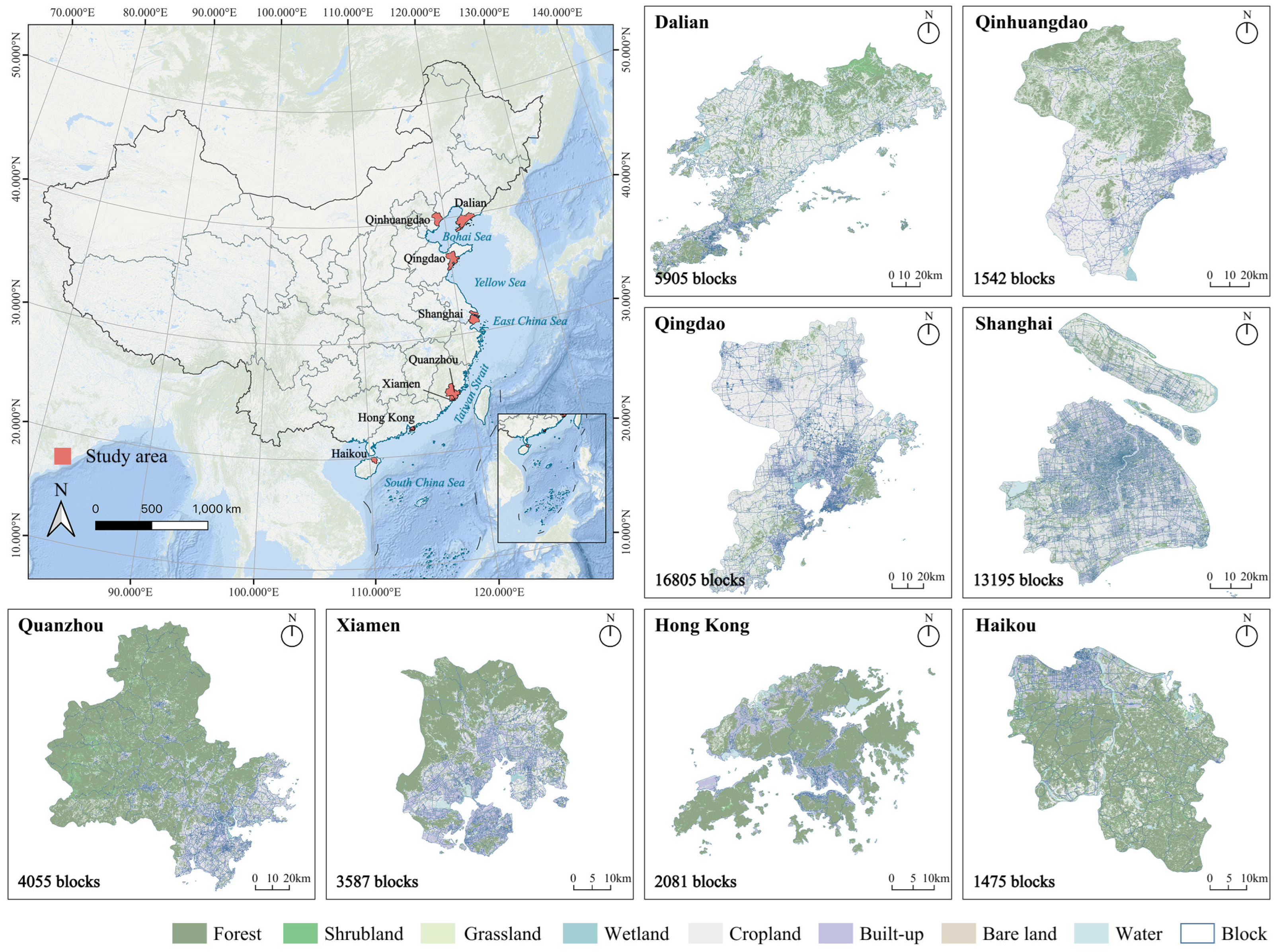

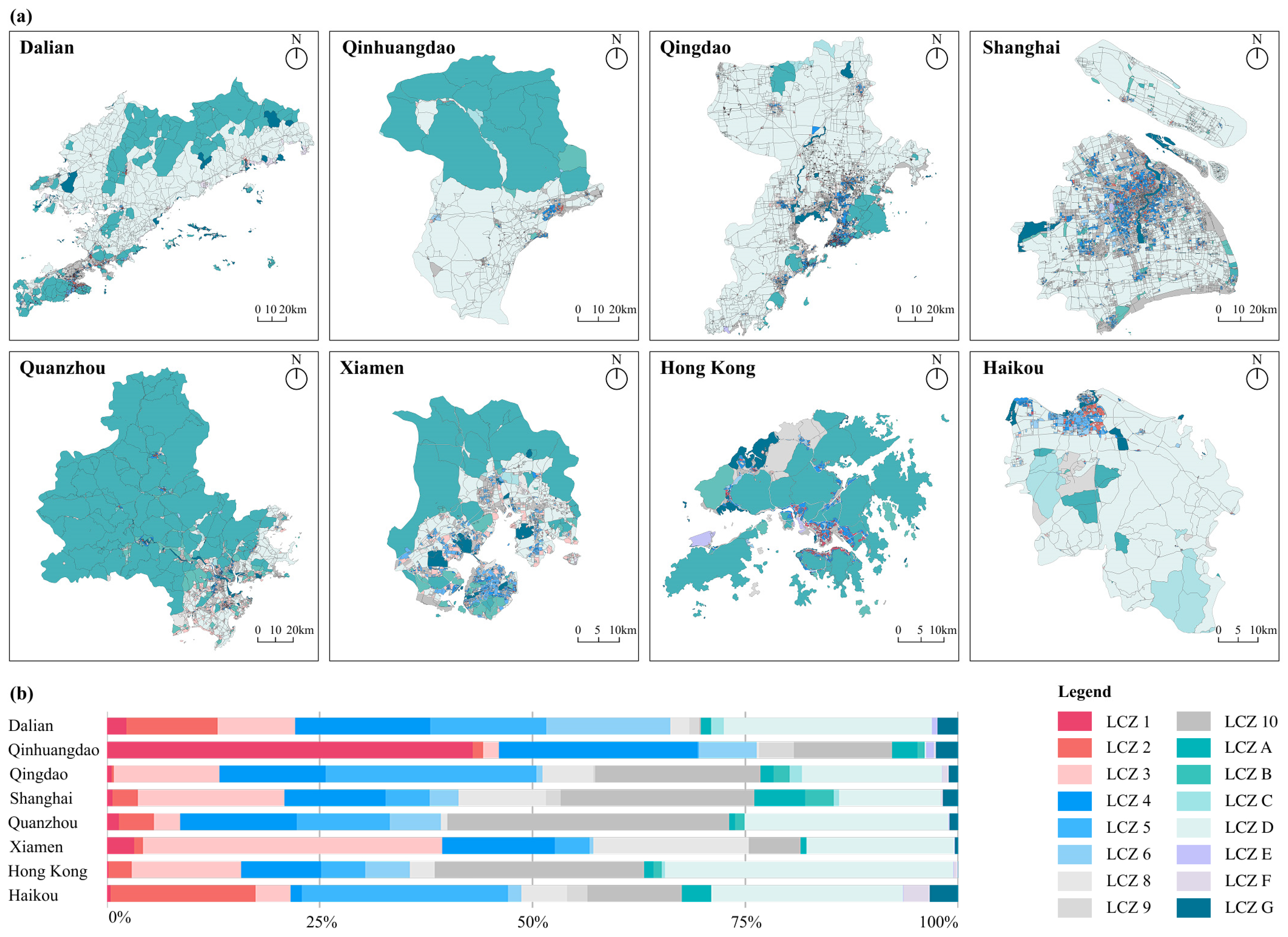

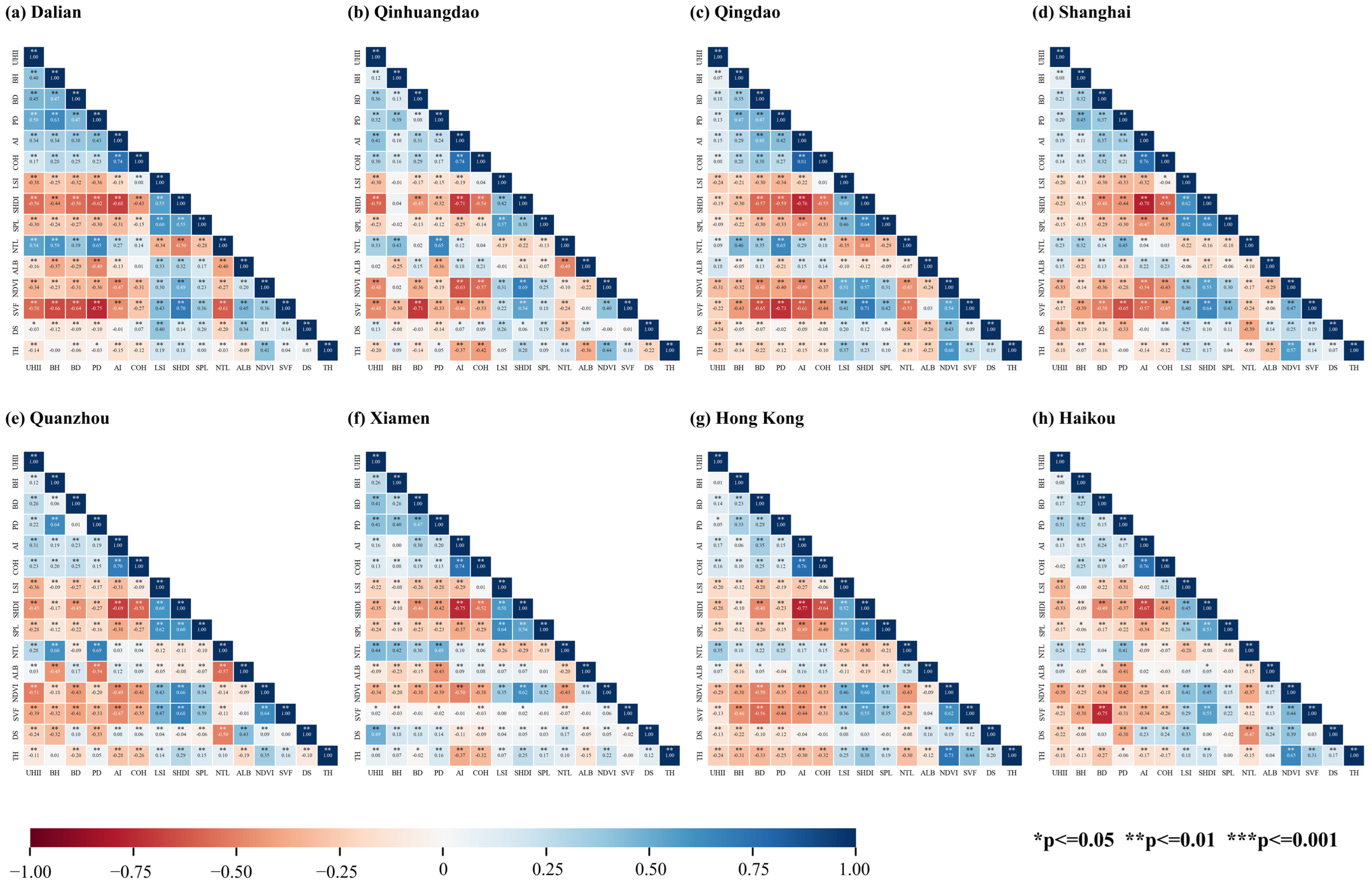

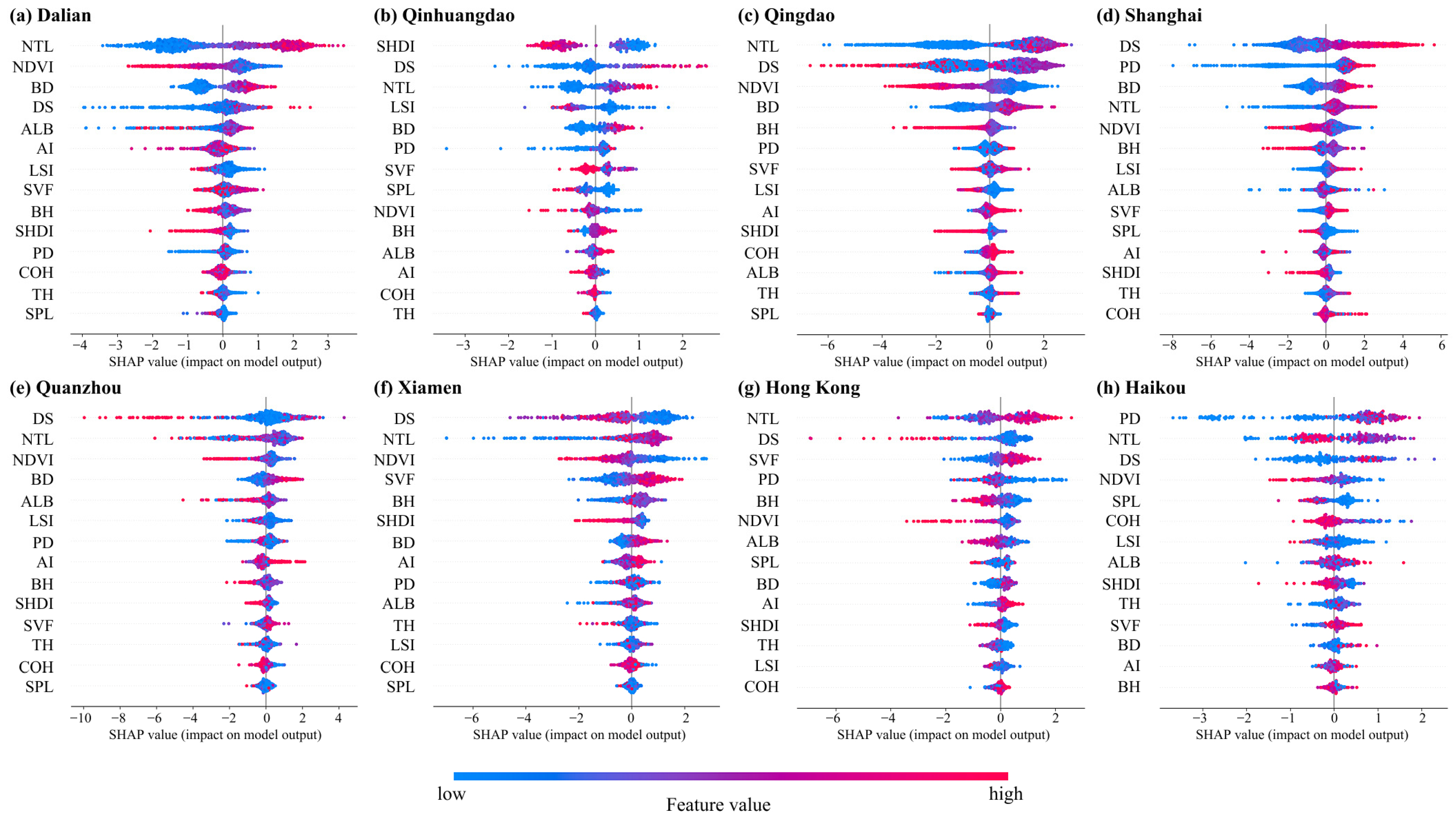
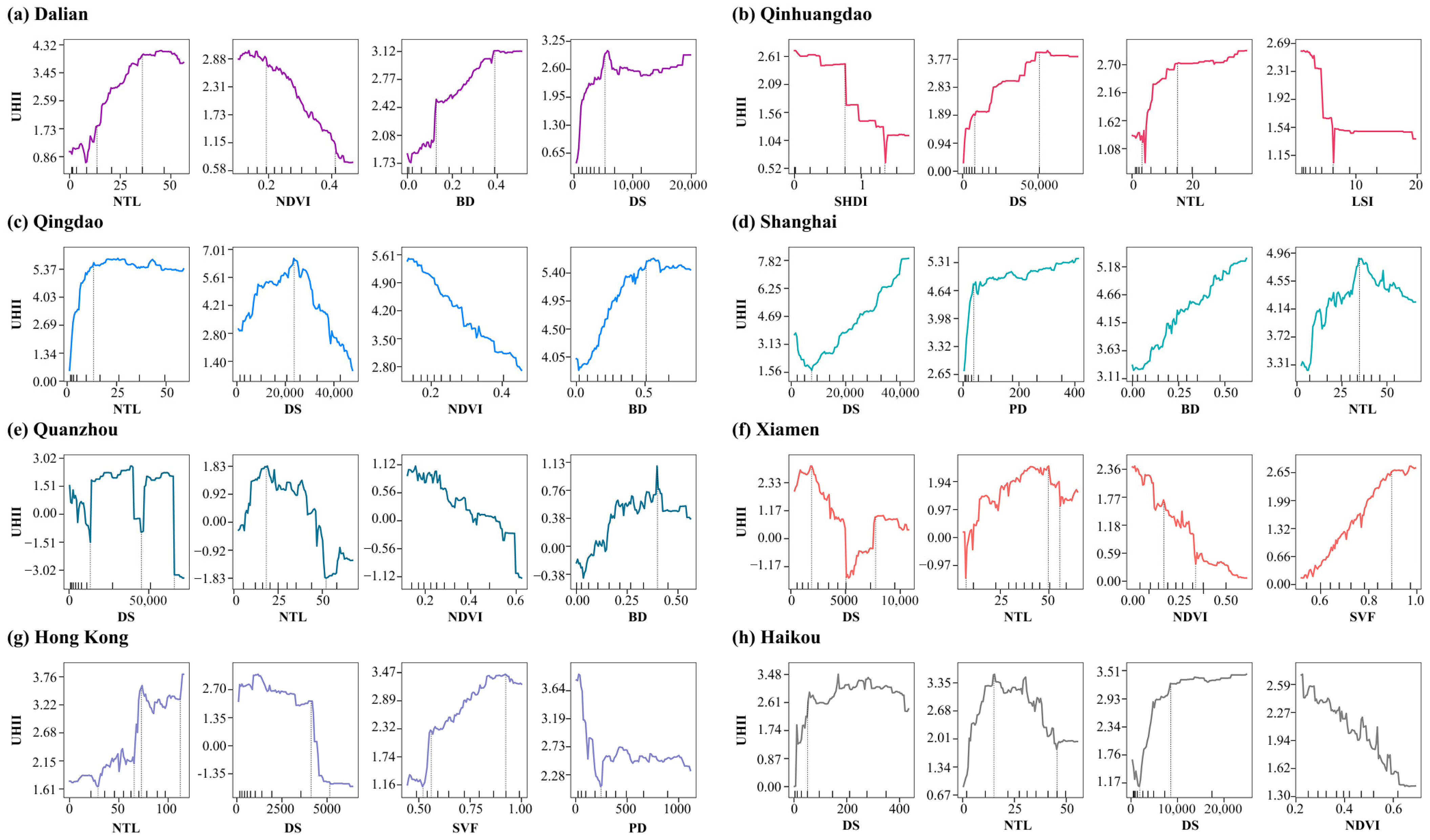
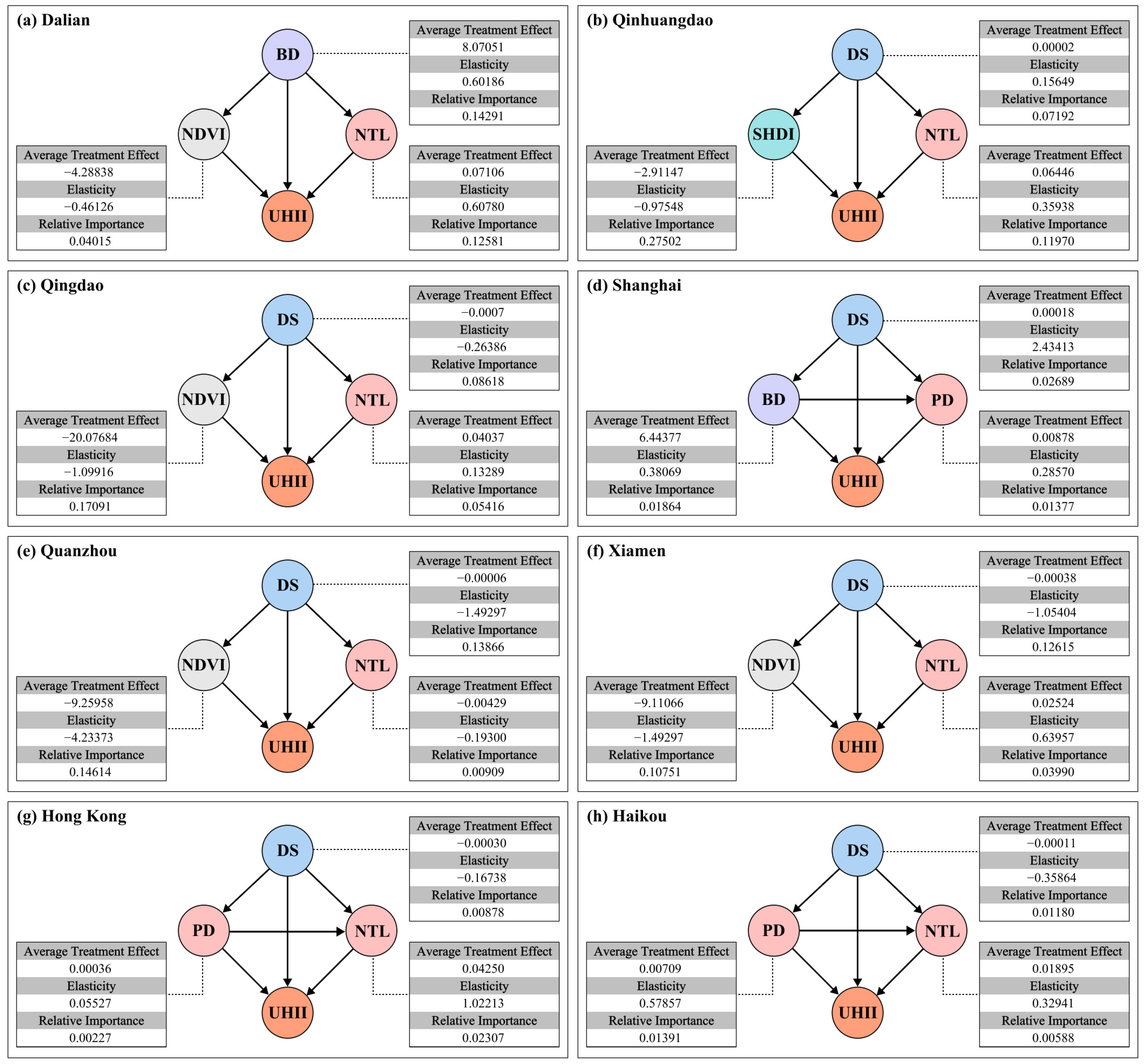
| Type | Spatial Resolution | Data | Sources |
|---|---|---|---|
| Landsat 8 collection 2 product | 30 m | 1 June 2023 to 15 August 2023 | USGS (https://earthexplorer.usgs.gov/) |
| Block division data | - | 2022 | MSDCW Dataset |
| Building data | - | 2020 | 3D-GloBFP: the first global three-dimensional building footprint dataset |
| Land use/cover data | 10 m | 2023 | GLC_FCS10: global 10 m landcover dataset |
| Population density data | 100 m | 2020 | A 100 m gridded population dataset of China’s seventh census using ensemble learning and geospatial big data |
| Tree height data | 10 m | 2023 | Sub-meter resolution canopy height maps |
| Nighttime light data | 100 m | 2023 | Global NPP-VIIRS-like nighttime light (2000–2023) |
| China coastline data | - | 2023 | Openstreet map |
| Category | Factors | Unit | Abbreviation |
|---|---|---|---|
| Biophysical parameters | Albedo | - | ALB |
| Normalized difference vegetation index | - | NDVI | |
| Building morphology | Building density | - | BD |
| Building height | m | BH | |
| Sky view factor | - | SVF | |
| Landscape Indicators | Aggregation index | % | AI |
| Patch cohesion index | % | COH | |
| Landscape shape index | - | LSI | |
| Shannon’s diversity index | - | SHDI | |
| Split index | - | SPL | |
| Tree height | m | TH | |
| Geography | Distance from sea | m | DS |
| Social Indicators | Nighttime light | - | NTL |
| Population density | people/ha | PD |
| Dalian | Qinhuangdao | Qingdao | Shanghai | Quanzhou | Xiamen | Hong Kong | Haikou | |
|---|---|---|---|---|---|---|---|---|
| Overall accuracy | 0.87544 | 0.86940 | 0.93605 | 0.80359 | 0.84758 | 0.85370 | 0.87459 | 0.85073 |
| Kappa coefficient | 0.84169 | 0.84608 | 0.90253 | 0.75301 | 0.82308 | 0.83184 | 0.84929 | 0.82169 |
| City | R2 | RMSE |
|---|---|---|
| Dalian | 0.757572705 | 1.827308654 |
| Qinhuangdao | 0.587108975 | 2.270995959 |
| Qingdao | 0.797621328 | 1.95885009 |
| Shanghai | 0.758993097 | 2.36471014 |
| Quanzhou | 0.435234333 | 4.094986159 |
| Xiamen | 0.482426761 | 3.244835661 |
| Hong Kong | 0.453910816 | 2.926233686 |
| Haikou | 0.433073275 | 3.060312293 |
Disclaimer/Publisher’s Note: The statements, opinions and data contained in all publications are solely those of the individual author(s) and contributor(s) and not of MDPI and/or the editor(s). MDPI and/or the editor(s) disclaim responsibility for any injury to people or property resulting from any ideas, methods, instructions or products referred to in the content. |
© 2025 by the authors. Licensee MDPI, Basel, Switzerland. This article is an open access article distributed under the terms and conditions of the Creative Commons Attribution (CC BY) license (https://creativecommons.org/licenses/by/4.0/).
Share and Cite
Li, K.; Wang, H. Spatial and Data-Driven Approaches for Mitigating Urban Heat in Coastal Cities. Buildings 2025, 15, 3544. https://doi.org/10.3390/buildings15193544
Li K, Wang H. Spatial and Data-Driven Approaches for Mitigating Urban Heat in Coastal Cities. Buildings. 2025; 15(19):3544. https://doi.org/10.3390/buildings15193544
Chicago/Turabian StyleLi, Ke, and Haitao Wang. 2025. "Spatial and Data-Driven Approaches for Mitigating Urban Heat in Coastal Cities" Buildings 15, no. 19: 3544. https://doi.org/10.3390/buildings15193544
APA StyleLi, K., & Wang, H. (2025). Spatial and Data-Driven Approaches for Mitigating Urban Heat in Coastal Cities. Buildings, 15(19), 3544. https://doi.org/10.3390/buildings15193544





